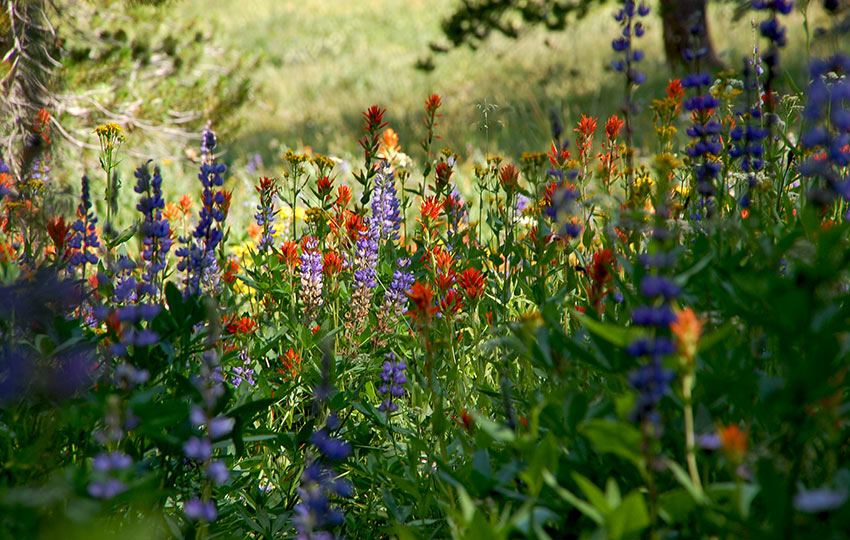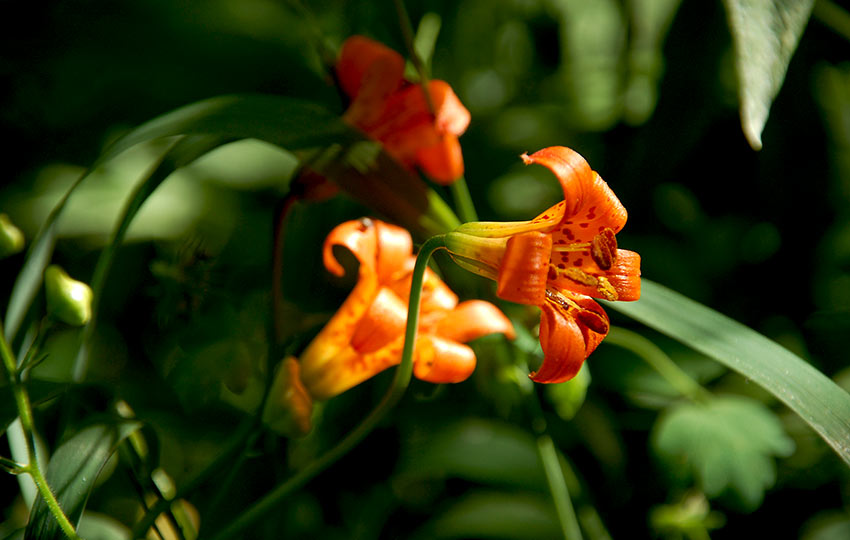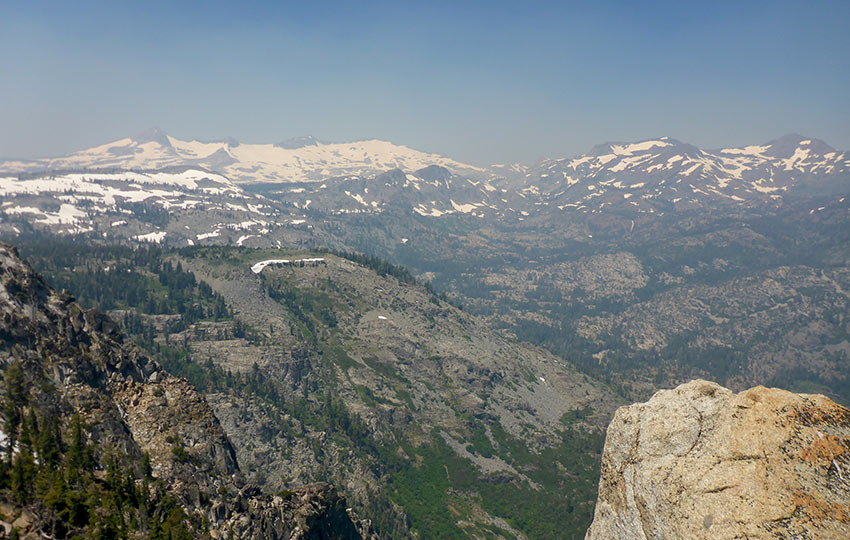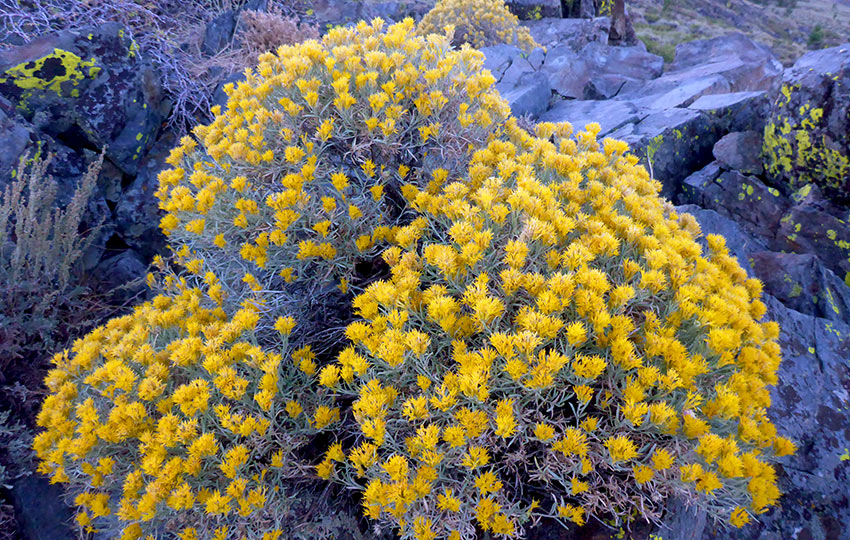
The United States is obviously composed of multiple climates. And, spring weather manifests at various times around the country. But May is usually the month that most Americans expect to see blooming flowers. This is evidenced by our use of the old English proverb April showers bring May flowers.
The Sierra Nevada Mountains at Lake Tahoe, on the other hand, doesn’t necessarily follow this adage. Our bloom season for wildflowers is more unpredictable than most US locations.
Simply put, Sierra Nevada wildflowers bloom within specific elevation ranges at specific times of the year.
For example, a wildflower that thrives in a wet environment (i.e. meadow) probably won’t bloom in August. That is, it probably won’t bloom in August at lower elevation meadows. This is because by late summer most of those meadows are dry. Essentially, the snowmelt and runoff from the previous winter has ceased. That said, you may still find that same variety of wildflower blooming at a higher elevation. Again, though, this is if the previous winter yielded a lot of snow.
Support Tahoe Trail Guide with a financial contribution via PayPal (single contribution) or Patreon (reoccurring contributions). Your support of Tahoe Trail Guide is very much appreciated!

Two primary factors (that go hand-in-hand) in determining ideal bloom times for Sierra Nevada wildflowers at Lake Tahoe are:
- the range in elevation of the Lake Tahoe Basin
- the previous winter’s snowpack
Range in Elevation of the Lake Tahoe Basin
The lowest point in the Lake Tahoe Basin is the lake itself (6,229 feet). The highest point is Freel Peak (10,881 feet). Doing the math shows us that there’s about 4,650 feet of elevation difference between those two points. So, this dramatic difference yields varying wildflower species and bloom times throughout the basin.
There are many species of wildflowers that grow at nearly any elevation in Tahoe. Woolly Mule’s Ears comes to mind. It often can be found growing at high and low elevations. However, many wildflowers (especially unique ones) have a very specific elevation range at which they’ll flourish. Or, a wildflower may have multiple sub-species. And each will have their own growing (elevation) range. I’m thinking of the Lupine genus in this latter example. There are numerous sub-species of Lupine at Lake Tahoe. And, many seem to prefer one elevation over another.
Consult current reference books and/or the citizen science-based website, iNaturalist when looking for a specific wildflower. Those resources often site the elevation ranges, climates, and time of year at which a given wildflower will reach its peak bloom.

Previous Winter’s Snowpack
When looking for specific wildflowers or fields of wildflowers in full bloom, the most important factor to consider is the previous winter’s snowpack.
Big Snow Years
The first reason is that the snowpack level determines the soil’s moisture content. A normal winter will produce wildflowers on track with what reference books typically list as their peak bloom times.
However, big snow winters can shift the bloom season by 1-2 months. “Normal” winters followed by cool spring temperatures have a similar effect.
So, the ground at lake level can be saturated well into June when the previous winter yielded a large snowpack. This is particularly evident in meadows such as Cathedral Meadows or Washoe Meadows State Park. Both of those meadows are located at lake level on the south shore of Lake Tahoe.
You could find yourself hiking through ankle-deep water following a big snowy winter depending on the area in which you’re traveling. This, at at a time where other places across the country are experiencing summer-like conditions.
But, by July, even after big winters the lower elevations are often dry and showing signs of summer. At the same time, the higher elevations will most likely still be holding multiple feet of snow.
Putting into Context a Big Snow Year
The winter of 2016/17 brought massive amounts of snow to the Lake Tahoe region. For example, the Palisades Tahoe/Alpine Meadows Ski Resorts (west Tahoe) reported a season total of 720 inches of snow. And Mount Rose Ski Resort (northeast side of Tahoe) reported a total of 768 inches of snow for the season!
Not surprisingly, the trail to Winnemucca Lake, at Carson Pass (South Tahoe) which sits at just over 9,000 feet was still mostly covered in snow by July of 2017. I mention the Winnemucca Lake trail because it’s a favorite among Sierra Nevada wildflower enthusiasts. This is due to the diverse soil and terrain found in the area.
Even Lake Aloha, which is at 8,116 feet (Desolation Wilderness), was still covered with snow on July 8, 2017.
Lastly, to provide more context for how crazy things can be here at Lake Tahoe … the Palisades Tahoe/Alpine Meadows Ski Resorts officially concluded their 2016/17 ski season on July 15th! Keep in mind, that even after big snow winters most Tahoe ski resorts do close in mid-April. This is because the ski resorts start experiencing diminishing returns. They might have enough snow, but the customers stop showing up. So just because the ski resorts may be closed doesn’t mean that there’s not tons of snow in the backcountry.

Low Snow Years
Following low snow and drought winters, you can usually find dry trails at lower elevations by April (below 8,000 feet). And you’ll often see wildflowers blooming by May.
In those same dry years, you might even be able to hike as early as March. However, don’t expect to see any wildflowers at that point. During a dry year, the peak bloom season may shift ahead by a month or more. And, due to the lack of moisture in those dry years the wildflowers may peak for only a few days. Essentially, those wildflowers may only peak for a fraction of their normal bloom time.
Many visitors to Tahoe often miss out on peak bloom times during low snow years. This is because many of those wildflowers bloom well before people begin their summer vacations.
Parting Thoughts About Peak Bloom Times for Lake Tahoe Wildflowers
Again, the two most important factors to consider when searching for Sierra Nevada wildflowers is the elevation at which you’re traveling and the previous winter’s snowpack.
My recommendation is to consider the time of year in which you’re visiting Lake Tahoe. Then, research what the current snowpack level. This will help you choose best where to hike. Often, though, when traveling to Tahoe in the early summer you’re going to want to hike at locations closer to lake level. This is because there’s usually snow still present at higher elevations into June and July.
Read my companion article featuring tips for finding Lake Tahoe wildflowers.

Question of Intention aka Conclusion
Why is it important to know about these critical factors that affect Lake Tahoe wildflowers? Or, why is it important to know about the wildflowers of Lake Tahoe at all? Well, you got me there.
If we’re going down that path I guess the broader and more relevant question to ask is, “Why is learning anything about nature important?”
I write these natural history articles to share with you entertaining and educational material that’ll enhance your outdoor experience. These works won’t transform you into world-famous botanists, for example. Their scope is relatively limited, all things considered. But they do provide a starting point for your own research. It’s my hope that after answering some basic questions about the wildflowers that you can find at Lake Tahoe, that you’d continue to ask questions.
- Why does it grow here?
- What is its connection to the landscape?
- Is it native or was it introduced to the region by humans (anthropogenic)?
- Or, was it brought here by wildlife?
- How does it benefit wildlife?
- Can it be eaten or consumed by humans?
- And, does it have medicinal properties?
As much as I’d love to be able to answer all of those questions, that would entail writing an entire book. And that’s not really what I’m trying to accomplish here.
Again, let’s just start by taking a closer look at our surroundings the next time we go outside. Because the more we become aware of the flora/fauna around us, the more we become invested in preserving it.
Best Wildflower Hikes of Lake Tahoe
Please note that this is an abridged list of Tahoe wildflower hikes. There are countless wildflower hikes at Tahoe and it’s simply going to take me time to compile them all. In the meantime, here’s a start. Please note that those locations without a link are articles I’ve yet to write.
- Winnemucca Lake
- Frog Lake
- Washoe Meadows State Park
- Cathedral Meadow
- Spooner Lake
- Rabe Meadow
- Meek’s Creek
- Paige Meadows
- Tahoe Meadows
- Watson Lake
- Freel Meadows
Articles About Lake Tahoe Plants and Wildlife
The following Tahoe Trail Guide articles feature information, history, and stories about the various forms of plant and wildlife that you can find at Lake Tahoe.
Lake Tahoe Wildflowers
- Two Major Factors that Determine Peak Bloom Times for Wildflowers at Tahoe
- Tips for Finding Wildflowers at Tahoe
- The Sinister Mustard Flower Rust
- Big Yellow Wildflowers with Big Green Leaves called Woolly Mule’s Ears and Arrowleaf Balsamroot
Trees of the Sierra Nevada
Birds of Lake Tahoe
- The Tree Cleaving Pileated Woodpecker
- How Woodpecker Contribute to Healthy Forests at Lake Tahoe (and other fun facts)
I’m planning on going to Carson Pass/ Lake Winnemucca on July 15th. What’s your guess on the wildflower bloom ? I think the Carson Ranger Station (volunteers) is not going to open this year.
Hey Ann,
Thanks for getting in touch! Full disclosure … I haven’t been to Carson Pass since this whole coronavirus thing hit (conscious decision to stay out of the backcountry, and then my summer full-time job started so I haven’t had time), but I suspect that there’ll be wildflowers in bloom when you visit Winnemucca Lake. We did have a few feet of snow in mid-March and there’s still large snow patches all along that north side of Round Top (I can see it in the distance from my commute to work), but I imagine the wildflowers will be blooming. And, because it wasn’t actually a big snow year (in spite of March storms) you’ll probably hit it at the right time.
If I visit Carson Pass before your trip, I’ll let you know what I find. Other than that, I hope you have a great hike and are keeping busy and safe!
Hello,
Can you let me know what month would be best to see the wildflowers bloom at Mount Rose Summit for 2020? I am in Jacksonville Florida so I am not sure what month I should buy my plane ticket for. Thank you,
Ken Kurose
Hey Ken,
Thanks so much for getting in touch! However, you ask a tricky question 🙂
At this point in the year (February 2, 2020), it’s pretty much impossible to know. The reason I say that is because last February (2019) we received the lion’s share of our winter snow. The amount of snow we received in February (aka #februburied) was so much that it extended the winter at Lake Tahoe until June. My last day of skiing for the 2018/19 season was on June 13th. And, I could’ve continued to ski had I wanted to for at least a couple more weeks. That was at Carson Pass, which is over 8,000 feet. This is a similar elevation to the Mount Rose trailhead/trail. Although, Mount Rose summit is well over 10,000 feet. And, I was still finding an extraordinary amount of wildflowers in full bloom at Carson Pass in the middle of September.
So, until we make it through February and into March (we occasionally get #miraclemarch snowfalls, too), I wouldn’t even hazard a guess with money at stake (plane tickets, accommodations…). If it winds up being a drought for the remainder of the winter, June could be a reasonable bloom time. However, if we receive substantial snow between now and March, we could be looking at a bloom in August.
I wish I could be more specific, but mother nature doesn’t care about our plans. So, I’d recommend waiting until mid-March (at the earliest) to start planning any wildflower trips out here.
Keep in touch, and let me know if you have any other questions!
Jared,
Thank you very much for replying back to me. I really appreciate the information and I will check back in next month. Great information and appreciate you taking time writing me back..
Ken Kurose
Hey Ken,
Glad I could provide some helpful info! It was actually a really dry February (2020), but yesterday (March 1st) Tahoe received between 4-10 inches of snow depending on location and elevation. So, we’re still looking at winter for the time being, with a little more precipitation forecasted for next week. Once we make it through March, it’s much easier to plan for the summer.
Hope you’re having a good winter where you’re at 🙂
Who has speculation on when the peak wildflower explosion will be for the Carson Pass 7-8k area will look like this summer?
Hey Dan,
I just looked at my summer photos from 2017 (following the 2016/17 Snowpocalypse winter at Lake Tahoe) and saw that the peak bloom at Winnemucca Lake was at the end of July and beginning of August. I know this winter (2018/19) hasn’t been exactly like the 16/17 season, but I would bet that the wildflower explosion at Carson Pass will be around the end of July again. There’s still so much snow in the upper elevations!